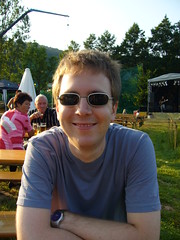Of course, if you have a mountain of loot you probably want to protect it. Enter the lawyers. Millennium had always filed on their discoveries; now they had lots of discoveries to protect. But protect from what? Well, the paranoia was a loss of "Freedom to Operate", usually known as FTO. Nobody knew what would stand up as a patent -- but there were instructive examples from the early biotech era of business plans sunk by a loss of FTO -- and expensive lawsuits that clearly marked that loss. So the patenting engine took off -- an expensive insurance policy against an unpredictable future.
[...]
This was the late 90's and the hype was getting thick -- we were guilty but so were others. Millennium wasn't a big pusher of high gene counts -- at least in the terms of the day (but that's another whole story), but certainly we started selling all those genes we had & the ones we extrapolated were still out there. A key part of the business model was to sell the genes many times -- if we could sell the same gene to Lilly for cardiovascular & Roche for metabolic and AstraZeneca for inflammation, all the better. Not that anything underhanded went on; we'd present the case to each company & most of the deals had exclusivity only within a therapeutic area.
Auf den Punkt mit der Genzahl ist er dann in einem weiteren Post genauer eingeganen. Woher kamen die unheimlich großen Zahlen in den Schätzungen, wieviele Gene im menschlichen Genom zu finden sind, zu einer Zeit bevor die menschliche Genomsequenz veröffentlicht war? 50 000, 100 000, oder vielleicht sogar 200 000? Wohl hauptsächlich Konkurrenz. Wenn die Biotechfirmen A und B beide mit Bioinformatik und viel Fleiß an den Sequenziergeräten Datenbanken mit menschlichen Genen zusammenstellen und diese verkaufen wollen, etwa an Pharmafirmen, welche Datenbank wird dann eher gekauft? Solange man sich nur auf grobe Schätzungen verlassen kann vorsichtshalber die mit doppelt so viel Genen. So hat sich das dann langsam hochgeschaukelt in sehr luftige Höhen. Selber schuld, wenn alle mitspielen. Umso ernüchternder war für die Kunden dann das Resultat aus dem Human Genome Project: ca. 25 000 bis 30 000 Gene, die in den letzten Jahren dann auf eher 22 000 bis 23 000 zusammengeschrumpft sind.
Das soll aber nicht heißen, dass sich nicht ein paar Leute schon in den Neunzigern darüber Gedanken gemacht hätten:
So my colleague tried a new approach, which I think was to say: we have a few percent of the human genome sequences (albeit mostly around genes of interest and not randomly sampled). How many genes have been found? And what would that extrapolate out to for the whole genome.
His conclusion was so shocking I admit I refused to believe it at first, and never quite bought into it. I think it was about 25-30K. How could the textbooks be off by 2X-3X? I could believe the other genomics companies might be optimistic in interpreting their data, but could they really be deluding themselves that much??
But, the logic was hard to assault. In order for his estimate to be low by a lot, you would have to posit that the genomic regions sequenced to date were unusually gene poor -- and that the rest of the genome was packed.
Beide Artikel sind sehr lesenswert, und schon allein deshalb interessant, weil man über die jungen Jahre der Genomik meistens nur von der Seite der akademischen Forschung hört.






Keine Kommentare:
Kommentar veröffentlichen